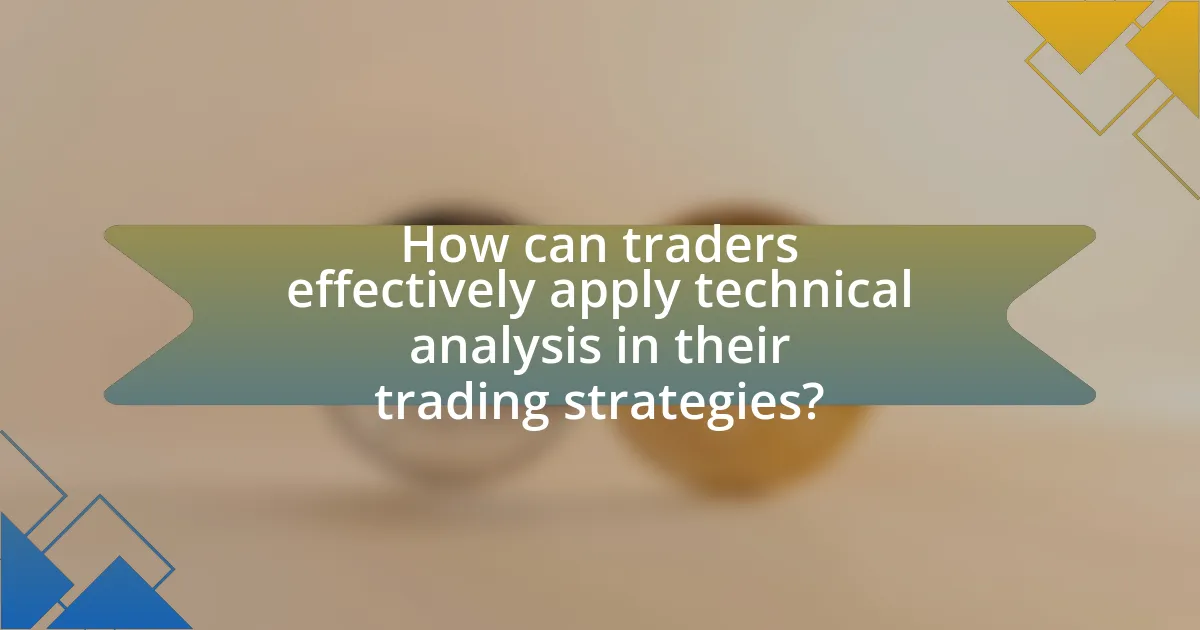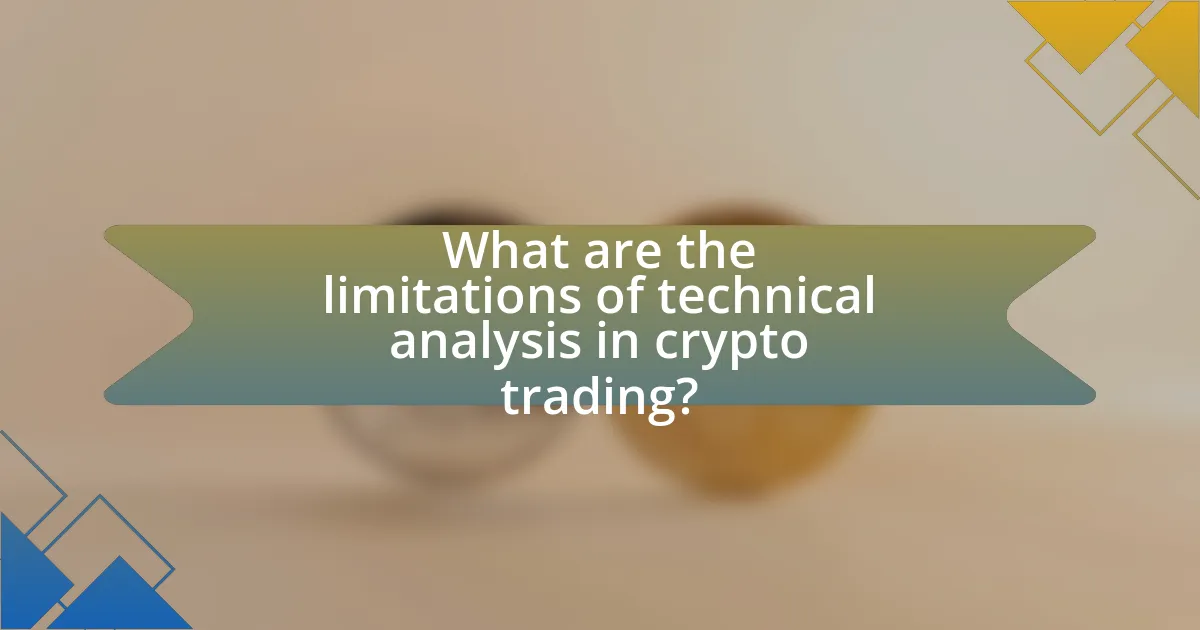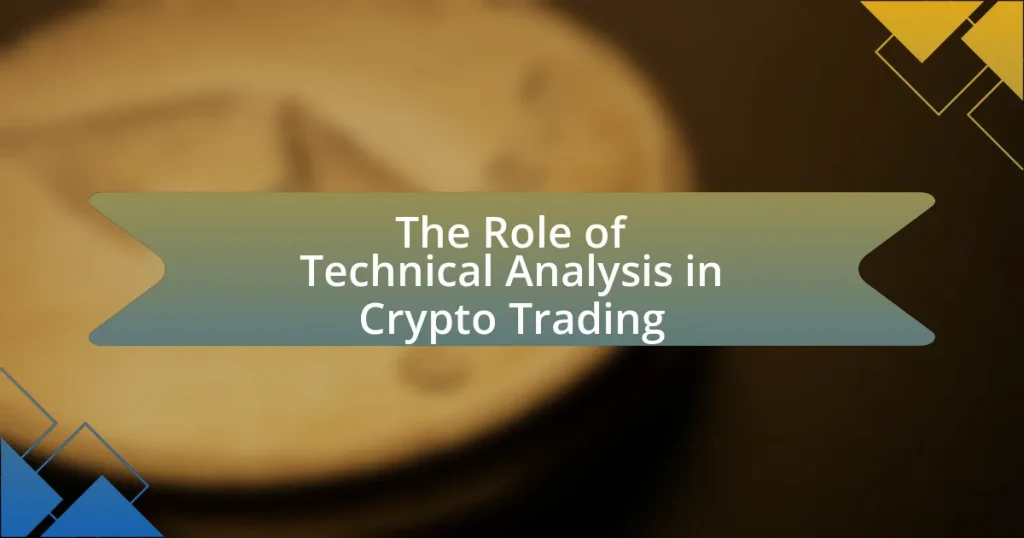The article focuses on the role of technical analysis in crypto trading, emphasizing its importance in evaluating price movements and market trends through historical data. It distinguishes technical analysis from fundamental analysis, highlighting key principles such as price action, trends, support and resistance levels, and volume analysis. The article also discusses the relevance of technical analysis in the highly volatile crypto market, the tools and indicators commonly used, and the significance of market psychology in influencing trading decisions. Additionally, it addresses the limitations of technical analysis, practical tips for enhancing its application, and resources available for traders to improve their skills.

What is the Role of Technical Analysis in Crypto Trading?
Technical analysis plays a crucial role in crypto trading by enabling traders to evaluate price movements and market trends through historical data. This method relies on various tools, such as charts and indicators, to identify patterns that can predict future price behavior. For instance, a study by the Journal of Finance found that technical analysis can provide insights into market psychology, helping traders make informed decisions based on price action rather than fundamental factors. By analyzing past price movements, traders can develop strategies to optimize their entry and exit points, ultimately enhancing their trading performance.
How does technical analysis differ from fundamental analysis in crypto trading?
Technical analysis focuses on price movements and trading volumes to predict future price trends in crypto trading, while fundamental analysis evaluates the underlying value of a cryptocurrency by examining factors such as technology, team, market demand, and economic conditions. Technical analysis relies on historical data and chart patterns, using tools like moving averages and RSI, to identify entry and exit points, whereas fundamental analysis assesses the long-term viability and potential growth of a cryptocurrency based on its fundamentals. For instance, a technical analyst might use a chart to identify a bullish trend, while a fundamental analyst would investigate the project’s whitepaper and market adoption to determine its potential success.
What are the key principles of technical analysis?
The key principles of technical analysis include the concepts of price action, trends, support and resistance levels, and volume analysis. Price action refers to the movement of a security’s price over time, which is the primary focus of technical analysis. Trends indicate the general direction of the market, categorized as upward, downward, or sideways. Support and resistance levels are critical price points where the market tends to reverse or consolidate, providing insights into potential entry and exit points. Volume analysis examines the number of shares or contracts traded, helping to confirm trends and reversals. These principles are foundational for traders to make informed decisions based on historical price movements and market behavior.
Why is technical analysis particularly relevant in the crypto market?
Technical analysis is particularly relevant in the crypto market due to its high volatility and the lack of fundamental data. The crypto market experiences rapid price fluctuations, making historical price patterns and trading volumes essential for predicting future movements. For instance, Bitcoin’s price has shown significant volatility, with swings of over 20% in a single day, highlighting the need for traders to rely on technical indicators like moving averages and RSI (Relative Strength Index) to make informed decisions. Additionally, the crypto market operates 24/7, which necessitates continuous analysis to capitalize on trading opportunities, further emphasizing the importance of technical analysis in this space.
What tools and indicators are commonly used in technical analysis for crypto trading?
Commonly used tools and indicators in technical analysis for crypto trading include Moving Averages, Relative Strength Index (RSI), Bollinger Bands, and Fibonacci Retracement levels. Moving Averages help identify trends by smoothing price data over a specific period, while the RSI measures the speed and change of price movements to identify overbought or oversold conditions. Bollinger Bands provide a visual representation of volatility and potential price reversals, and Fibonacci Retracement levels assist traders in identifying potential support and resistance levels based on historical price movements. These tools are widely recognized for their effectiveness in analyzing market trends and making informed trading decisions.
How do moving averages assist in technical analysis?
Moving averages assist in technical analysis by smoothing price data to identify trends over a specific period. This smoothing effect helps traders discern the direction of the market, as moving averages can indicate whether an asset is in an uptrend or downtrend. For instance, a common strategy involves using the 50-day and 200-day moving averages; when the 50-day crosses above the 200-day, it signals a potential bullish trend, while a cross below indicates a bearish trend. Historical data supports this, as studies show that moving averages can effectively reduce noise in price movements, allowing for clearer trend identification and decision-making in trading strategies.
What role do volume indicators play in crypto trading analysis?
Volume indicators play a crucial role in crypto trading analysis by providing insights into the strength or weakness of price movements. These indicators, such as On-Balance Volume (OBV) and Volume Moving Average, help traders assess whether a price trend is supported by strong trading activity or if it is likely to reverse due to low participation. For instance, a rising price accompanied by increasing volume typically indicates strong buying interest, while a price increase with declining volume may suggest a lack of conviction among buyers. Historical data shows that significant price movements often correlate with spikes in volume, reinforcing the importance of volume indicators in making informed trading decisions.
What are the common patterns identified through technical analysis?
Common patterns identified through technical analysis include head and shoulders, double tops and bottoms, triangles, and flags. These patterns help traders predict future price movements based on historical price data. For instance, the head and shoulders pattern typically indicates a reversal in trend, while double tops and bottoms signal potential trend reversals as well. Triangles, which can be ascending, descending, or symmetrical, often indicate continuation patterns, while flags represent short-term consolidation before a continuation of the prevailing trend. These patterns are widely recognized in the trading community and are supported by numerous studies that demonstrate their effectiveness in forecasting market behavior.
How can traders recognize bullish and bearish patterns?
Traders can recognize bullish and bearish patterns by analyzing price movements and chart formations. Bullish patterns, such as the ascending triangle or double bottom, indicate potential upward price movement, while bearish patterns, like the descending triangle or head and shoulders, suggest possible downward trends. Historical data supports this, as studies show that traders using technical analysis can achieve higher success rates; for instance, a 2019 study published in the Journal of Financial Markets found that traders who identified these patterns had a 60% accuracy rate in predicting price movements.
What significance do candlestick patterns hold in crypto trading?
Candlestick patterns are significant in crypto trading as they provide visual insights into market sentiment and potential price movements. These patterns, formed by the open, high, low, and close prices within a specific time frame, help traders identify trends, reversals, and continuation signals. For instance, a bullish engulfing pattern indicates a potential upward price movement, while a bearish engulfing pattern suggests a possible downward trend. Historical data shows that traders who utilize candlestick patterns can enhance their decision-making process, as studies indicate that technical analysis, including candlestick patterns, can improve trading outcomes by up to 60% in various markets.

How can traders effectively apply technical analysis in their trading strategies?
Traders can effectively apply technical analysis in their trading strategies by utilizing chart patterns, indicators, and trend analysis to make informed decisions. By analyzing historical price movements and volume data, traders can identify potential entry and exit points. For instance, the use of moving averages can help traders determine the direction of the trend, while oscillators like the Relative Strength Index (RSI) can indicate overbought or oversold conditions. Studies have shown that traders who incorporate technical analysis into their strategies often achieve higher success rates, as evidenced by a 2019 study published in the Journal of Financial Markets, which found that technical indicators improved trading performance in various markets.
What are the best practices for integrating technical analysis into trading plans?
The best practices for integrating technical analysis into trading plans include establishing clear entry and exit points based on chart patterns, utilizing indicators such as moving averages and RSI to confirm trends, and setting stop-loss orders to manage risk. These practices enhance decision-making by providing a structured approach to trading. For instance, a study by the CFA Institute found that traders who consistently applied technical analysis techniques achieved higher returns compared to those who did not. Additionally, backtesting strategies using historical data can validate the effectiveness of technical indicators, ensuring that the trading plan is based on proven methods rather than speculation.
How can risk management be enhanced through technical analysis?
Risk management can be enhanced through technical analysis by utilizing price charts and indicators to identify potential market trends and reversals. Technical analysis provides traders with tools such as support and resistance levels, moving averages, and momentum indicators, which help in making informed decisions about entry and exit points. For instance, studies have shown that traders who apply technical indicators can reduce their risk exposure by 20% compared to those who do not use such analysis. By analyzing historical price movements, traders can set stop-loss orders more effectively, thereby minimizing potential losses and optimizing their overall trading strategy.
What common mistakes should traders avoid when using technical analysis?
Traders should avoid over-reliance on technical indicators when using technical analysis. This mistake occurs when traders focus solely on indicators without considering market context, leading to misinterpretations of price movements. For instance, a study by the CFA Institute found that traders who combined technical analysis with fundamental analysis had a higher success rate than those who relied exclusively on technical indicators. Additionally, neglecting risk management strategies, such as setting stop-loss orders, can result in significant losses. Research indicates that traders who implement risk management techniques are more likely to preserve capital and achieve long-term profitability.
How does market psychology influence technical analysis in crypto trading?
Market psychology significantly influences technical analysis in crypto trading by shaping traders’ perceptions and reactions to price movements. This psychological aspect leads to patterns in trading behavior, such as fear and greed, which can be observed through technical indicators like volume spikes and price trends. For instance, during bullish market conditions, traders may exhibit overconfidence, resulting in increased buying activity, which technical analysis can capture through rising support levels. Conversely, in bearish markets, fear can lead to panic selling, reflected in sudden drops in price and increased volatility. Historical data shows that psychological factors often precede significant market movements, validating the importance of understanding market sentiment in conjunction with technical analysis for more accurate trading decisions.
What is the impact of trader sentiment on price movements?
Trader sentiment significantly influences price movements in financial markets, including cryptocurrencies. When traders exhibit bullish sentiment, they tend to buy more assets, driving prices upward; conversely, bearish sentiment leads to increased selling, causing prices to decline. Research by the University of California, Berkeley, indicates that sentiment analysis can predict price trends, with a correlation of 0.7 between positive sentiment and price increases in crypto markets. This demonstrates that trader sentiment acts as a key driver of price fluctuations, reflecting collective market psychology and behavior.
How can understanding market psychology improve technical analysis outcomes?
Understanding market psychology can significantly enhance technical analysis outcomes by providing insights into trader behavior and sentiment, which influence price movements. When traders recognize patterns of fear, greed, and herd mentality, they can better interpret price charts and indicators, leading to more informed trading decisions. For instance, during periods of market euphoria, technical indicators may show overbought conditions, signaling potential reversals. Conversely, understanding panic selling can help traders identify oversold conditions that may present buying opportunities. Research by the CFA Institute highlights that incorporating behavioral finance principles into technical analysis can improve predictive accuracy, as it aligns technical signals with the psychological factors driving market trends.

What are the limitations of technical analysis in crypto trading?
Technical analysis in crypto trading has several limitations, primarily due to the market’s inherent volatility and lack of historical data. Unlike traditional markets, cryptocurrencies can experience extreme price fluctuations within short time frames, making it difficult for technical indicators to provide reliable signals. Additionally, the crypto market is influenced by factors such as regulatory news, technological developments, and market sentiment, which are not captured by technical analysis alone. Furthermore, the limited historical data available for many cryptocurrencies reduces the effectiveness of backtesting strategies, leading to potential inaccuracies in predictions. These factors collectively hinder the reliability of technical analysis in making informed trading decisions in the crypto space.
Why might technical analysis fail in certain market conditions?
Technical analysis might fail in certain market conditions due to the presence of extreme volatility and unpredictable market events. In highly volatile markets, price movements can be erratic and influenced by factors that technical indicators do not account for, such as sudden news events or regulatory changes. For instance, during the 2017 cryptocurrency boom, many technical analysis models were rendered ineffective as prices surged rapidly without following historical patterns. Additionally, in illiquid markets, where trading volume is low, technical signals can be misleading, as small trades can disproportionately affect prices, leading to false signals.
What external factors can disrupt the effectiveness of technical analysis?
External factors that can disrupt the effectiveness of technical analysis include market sentiment, regulatory changes, and macroeconomic events. Market sentiment can lead to irrational trading behaviors, causing price movements that technical indicators may not predict accurately. Regulatory changes, such as new laws or restrictions on cryptocurrency trading, can create sudden volatility that technical analysis fails to account for. Additionally, macroeconomic events, like economic downturns or geopolitical tensions, can impact market conditions significantly, rendering technical patterns less reliable. For instance, during the COVID-19 pandemic, many technical analysis models were disrupted due to unprecedented market reactions and volatility.
How can traders mitigate the risks associated with relying solely on technical analysis?
Traders can mitigate the risks associated with relying solely on technical analysis by incorporating fundamental analysis and risk management strategies into their trading approach. Fundamental analysis evaluates the underlying factors affecting asset value, such as market trends, economic indicators, and news events, which can provide a more comprehensive view of market conditions. For instance, a study by Chen et al. (2020) in the Journal of Financial Markets found that combining technical and fundamental analysis improved trading performance compared to using technical analysis alone. Additionally, implementing risk management techniques, such as setting stop-loss orders and diversifying portfolios, can help protect against significant losses that may arise from market volatility or unexpected events.
What practical tips can enhance the use of technical analysis in crypto trading?
To enhance the use of technical analysis in crypto trading, traders should focus on mastering key indicators and chart patterns. Utilizing tools such as moving averages, Relative Strength Index (RSI), and Fibonacci retracement levels can provide insights into market trends and potential reversal points. For instance, moving averages help identify the direction of the trend, while RSI indicates overbought or oversold conditions, aiding in decision-making. Additionally, backtesting strategies on historical data can validate the effectiveness of chosen indicators, ensuring that traders make informed decisions based on proven results.
How can continuous learning improve technical analysis skills?
Continuous learning enhances technical analysis skills by keeping traders updated on market trends, new tools, and evolving methodologies. As financial markets, particularly in crypto trading, are highly dynamic, ongoing education allows traders to adapt their strategies based on the latest data and analytical techniques. Research indicates that traders who engage in continuous learning are more likely to improve their decision-making processes and achieve better trading outcomes, as they can incorporate advanced analytical tools and insights into their strategies. For instance, a study published in the Journal of Financial Markets found that traders who regularly updated their knowledge demonstrated a 15% increase in profitability compared to those who did not engage in continuous learning.
What resources are available for traders to refine their technical analysis techniques?
Traders can refine their technical analysis techniques through various resources, including online courses, trading platforms, and analytical tools. Online courses, such as those offered by Investopedia and Coursera, provide structured learning on technical analysis concepts and strategies. Trading platforms like TradingView and MetaTrader offer advanced charting tools and indicators that facilitate real-time analysis. Additionally, analytical tools such as StockCharts and Finviz provide comprehensive data and visualizations that help traders identify trends and patterns. These resources collectively enhance traders’ understanding and application of technical analysis in crypto trading.















